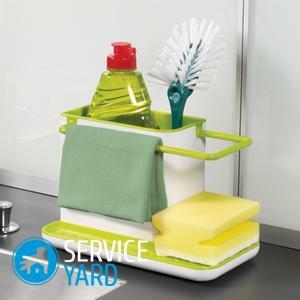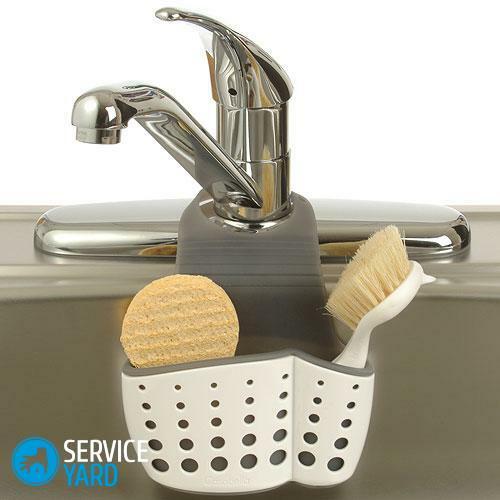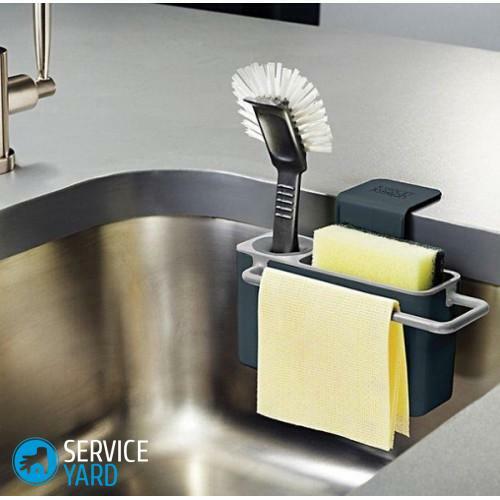
- How to choose a sponge
- What do sponges for washing dishes?
- How to choose a sponge in size and shape?
- Useful advices:
Do not wash dishes after eating can afford those people who prefer a homemade restaurant meal. Those who prepare a family breakfast every day, lunch, dinner at home, are simply obliged to perform this not always pleasant work. And to speed it up and bring the dishes to the ideal cleanliness and gloss, usually a sponge for utensils is used. But you can get the expected effect only if you choose the right device and apply it to a suitable type of dishes. In this article, we will look at what kind of sponge is for washing, how to choose it, how to use it and what else you need to know when using similar home implements.
to the contents ↑How to choose a sponge
To make the sponge for utensils really useful, convenient and significantly speed up the washing process, when buying, you should pay attention to:
- material from which it is made;
- form;
- dimensions.
Important! It will not be superfluous to clarify the manufacturer, too, in order to be sure that harmful substances were not used in the production of such household products.
to the contents ↑What do sponges for washing dishes?
The variety of sponges for washing dishes today is incredibly large. Some are suitable for a particular dish, others are universal. To quickly understand all this wealth of offers of modern manufacturers, you need to know the following features of each material.

Foam
Foam sponges are the most popular today due to their advantages and availability.
Pros:
- This material is soft, moderately delicate, so it can be used to remove fat from absolutely any surfaces, even with a very specific Teflon non-stick coating.
- Sponge for washing foam rubber very well foams any detergent, allowing you to save it.
- Low price.
- Convenient packaging with a different number of sponges - you can choose the packaging, focusing on your volume of dirty dishes every day.
Cons:
- The minus of such a device in its fragility.
- If you buy a product of poor quality, during soaking and drying, the foam will crumble right in your hands, leaving particles on the dishes. This will cause some inconvenience and additional water consumption for repeated washing of kitchen utensils.
Abrasive and foam rubber
Sponges with a double surface type with the appearance of household products immediately became more popular than conventional foam products. There are several reasons for this.
Advantages:
- The price remained affordable - an increase in cost compared to one-sided foam products is not significant even for those who are trying to save on everything.
- Versatile application. Such a sponge for washing is suitable for removing grease and light contaminants from any, even delicate materials of kitchen utensils, and for thorough washing of the fume. If necessary, with such a sponge you can clean the tiles on the walls, the stove, the bath, the sink - everything that will be convenient for washing it.
- A good degree of foaming of concentrated detergents.
- Possibility of purchasing as 1 piece, and packing from several multi-colored sponges.
Disadvantages:
- It is important to purchase products from a reliable manufacturer. Otherwise, either the foam will crumble, or the abrasive surface will not be sufficiently rigid.
Metal
Metallic "hedgehogs" are used by the mistresses for more than a decade. At the heart of such an adaptation, as a rule, is a thin wire twisted into a not very tight tangle.
Advantages:
- The cheapest price.
- Such a sponge for dishes is great for removing even the oldest dirt and a thick layer of carbon.
- Long service life, if based on high-quality and durable wire.
Disadvantages:
- Not suitable for cleaning delicate surfaces - enamel, plastic, non-stick coatings.
- With a thick layer of soot and soot, during operation, the grease mixed in the cleaning cloth can be clogged between the wire threads. The sponge for washing becomes sticky and very unpleasant to use.
- It is undesirable to use for regular washing of kitchen utensils every day, since liquid fat such a sponge does not absorb and does not remove, and the remainder of food will be clogged in the gaps between the wires.

Cellulose
Cellulose sponges for washing are also present in the lineup of various manufacturers of household chemicals and improvised equipment. And it is they who are recommended to give preference to employees of the centers of analysis and certification of different goods.
Pros:
- The environmental cleanliness of the raw materials is based.
- Hypoallergenicity.
- Antibacterial properties.
Disadvantages:
- Not always a reasonable price.
- Suitable is a sponge for washing not only dishes, but also any plumbing, especially for those that require a high level of hygienic cleanliness - a bath, a sink.
Plastic
Modern production can not do without plastic, including the manufacture of sponges for dishes. What features are typical for these products. Pros:
- Long period of use.
- Possibility to clean even complex dirt - plastic products differ in a certain degree of rigidity.
- Delicate cleaning of dishes from any material.
- Affordable price.
Cons:
- Synthetic composition, so you need to be confident in the manufacturer, so as not to harm yourself and your loved ones.
- Risk of allergy.
- Undesirable regular daily use.
Microfiber
Sponge crock of this material is very interesting from all sides.
Pros:
- No detergent is required - a sponge for washing itself cleanses even a large amount of fat.
- Hypoallergenic and environmentally friendly.
- Suitable for regular daily use.
- Gently cleans the surfaces of any materials.
Cons:
- High price compared to any other kinds.
- A thick layer of sludge to remove such a sponge is quite difficult.
Important! As a rule, in the arsenal of each hostess should not be one kind of sponge for utensils. It is desirable, if there are any different devices in this or that quantity, with which you can clean quickly and easily different surfaces, containers.
to the table of contents ↑How to choose a sponge in size and shape?
Size and shape are also important for the quality of dishwashing. Therefore, given these parameters, you simply have to pay a certain share of your attention. However, note the following recommendations:
- Small sponges - are well suited for washing glasses, cups, glasses, but not very convenient for washing bulky plates, pans and pans. Are cheaper, but also wear out more quickly.
- Sponge for washing dishes of large format - more convenient for large kitchen utensils, longer serves, but costs a little more.
- Rectangular sponges are a traditional version of a dishwashing device that does not cause any discomfort during the application.
- Fingerprint products are considered an improved version with a higher level of ergonomics. As the manufacturers and some landladies say, they fit better in the hand and are more convenient, since they do not slip out.
- Round and oval - very convenient for washing large bowls and pots.
- Sponges with plastic handles are comfortable from the point of view of protecting the skin of hands and manicure. It helps to clean not only ordinary plates and pans, but also containers with a narrow neck - bottles, vases, jugs.
Important! The color solution remains always at personal discretion. Manufacturers of such inventory have taken care of that each mistress could pick up to itself more interesting and pleasant variant. So, for example, a sponge for utensils can be in one color scheme with kitchen towels, curtains or decor on walls, facades of a furniture set.
to the table of contents ↑Useful advices:
- Innovative melamine sponge is an excellent solution for cleaning different surfaces of furniture, flooring, and not only in the kitchen. But washing dishes with such devices is strictly not recommended due to the specific chemical composition of the products - melamine resin penetrates the structure of different materials. The only one where a rare use of such a kitchen accessory is permissible is the outer walls of enamel pots, kazanovs.
- To ensure your safety, change sponges at least once a week, especially if you have a large family and a usual dinner consists of several dishes. On such inventory various harmful microorganisms accumulate, which every day becomes more and more in the thickness of the material of the sponge. The result of this phenomenon can be, at least - intestinal disorders.
- To save on buying a new sponge for washing, you can disinfect already used - once a week. This can be done with vinegar, microwave oven or dishwasher. For processing, it is enough to put a sponge on a saucer in a microwave for 1 minute or to load it into a dishwasher for the entire washing cycle time. If you decide to disinfect with vinegar - put the sponge completely in it for 5 minutes, and then rinse thoroughly with running water.
Now you have full information not only about the types, materials, forms, appointment of sponges for washing, but also have some valuable tips how to keep dishes clean and your health. Use these recommendations constantly and let your kitchen always have a perfect order, the maintenance of which you will spend negligible time.



